Russian post office and stamps

A Russian post office was established at Karyai in the last years of the 19th century. The post office used Russian stamps for the Levant. A series of stamps overprinted "Mont-Athos" was issued in 1910. [1]
This is a survey of the postage stamps and postal history of Mount Athos .

A Russian post office was established at Karyai in the last years of the 19th century. The post office used Russian stamps for the Levant. A series of stamps overprinted "Mont-Athos" was issued in 1910. [1]
In accordance with the agreement concluded by the Hellenic Postal Service with the Holy Kinot of Mount Athos in May 2008, postage stamps are issued for use in the two post offices located in Mount Athos, in Karyai, the seat of administration, and in the port of Dafni at the foot of the mountain. [2]
In the winter of 1915–1916 the Allied forces were considering occupation of the Holy Mountain. In anticipation of this they prepared a set of stamps which were intended for issue on 25 January 1916 for the use of the Governing body of the Monastic Community. [3]
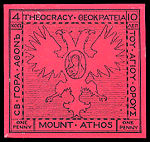

These stamps were produced in sheets of 12, (3 rows of 4), on board the seaplane carrier HMS Ark Royal. Six values were produced, ranging up to one shilling, and all were printed in black but on various different paper types.
The design of these stamps consisted of a square border with the name MOUNT ATHOS at the bottom in English, the left in Russian and on the right in Greek. At the top was inscribed THEOCRACY. The denomination appeared at each corner with the English in the lower corners, Greek in the top left and Russian in the top right. The inner section showed a double headed Byzantine eagle with the effigy of the Madonna and Child in an oval on its breast.
These stamps have no official status but fall into the category of prepared for use but not issued. [4]

For political reasons in 1916 the Greek Government overprinted Greek "Campaign 1912" and postage due (1913 issue) stamps, as well as postal stationery, with the inscription "Ι. Κοινότης Αγ. Όρους" (Holy Community of Sacred Mountain). The decision was reversed before the stamps were officially issued. [5]

Mount Athos is a mountain on the Athos peninsula in northeastern Greece. It is an important center of Eastern Orthodox monasticism. The mountain and most of the Athos peninsula are governed as an autonomous region in Greece by the monastic community of Mount Athos, which is ecclesiastically under the direct jurisdiction of the Ecumenical Patriarch of Constantinople. The remainder of the peninsula forms part of the Aristotelis municipality. Women are prohibited from entering the area governed by the monastic community by Greek law and by religious tradition.

An overprint is an additional layer of text or graphics added to the face of a postage or revenue stamp, postal stationery, banknote or ticket after it has been printed. Post offices most often use overprints for internal administrative purposes such as accounting but they are also employed in public mail. Well-recognized varieties include commemorative overprints which are produced for their public appeal and command significant interest in the field of philately.
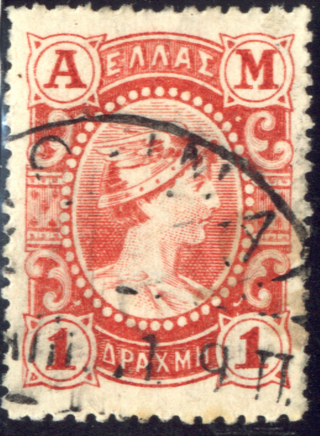
Greece's first postal service was founded in 1828, at the time of Greek independence from the Ottoman Empire. This initial service continued mail delivery and, later, the issuing of postage stamps until 1970. It was then succeeded by the Hellenic Post S.A., which remains Greece's official postal provider. The first Greek stamps were issued in 1861; by then, the postal service had expanded to operate 97 branches.
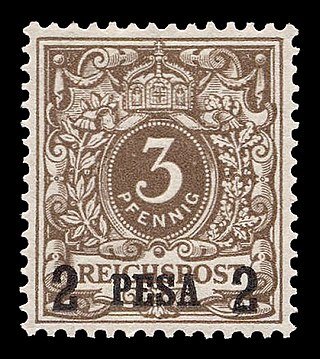
This is a survey of the postage stamps and postal history of German East Africa.

Eastern Rumelia or Eastern Roumelia was an autonomous province (vilayet) in the Ottoman Empire from 1878 to 1908; however, it was under Bulgarian control beginning in 1885. The province is remembered today by philatelists for having issued postage stamps from 1881 on, although a postcard was issued locally for internal use in 1880.
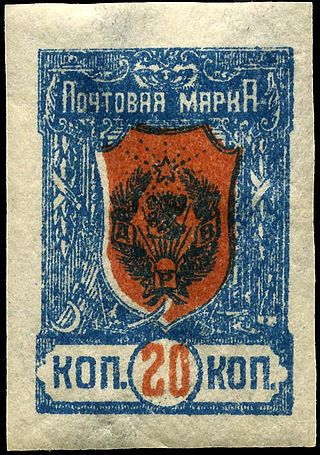
The Far Eastern Republic, sometimes called the Chita Republic, existed from April 1920 to November 1922 in the easternmost part of Siberia. It was formed from the Amur, Transbaikal, Kamchatka, Sakhalin, and Primorye regions. In theory, it extended from Lake Baikal to Vladivostok but, in May 1921, the Priamur and Maritime Provinces seceded. Although nominally independent, it was largely controlled by the RSFSR and its main purpose was to be a democratic buffer state between the RSFSR and the territories occupied by Japan during the Russian Civil War to avoid war with Japan. Initially, its capital was Verkhneudinsk, but from October 1920 it was Chita. On 15 November 1922, after the war ended and the Japanese withdrew from Vladivostok, the Far Eastern Republic was annexed by Soviet Russia.

The French post offices in Zanzibar were post offices operated by France in Zanzibar from January 16 1889 to July 31 1904, when the United Kingdom took direct control of what had previously been a protectorate.
The postal history of Northern Epirus, a region in the western Balkans, in southern modern Albania, comprises two periods; 1912–1916 and 1940-41. Northern Epirus was under Greek administration during the First Balkan War (1912–1913), but it was then awarded to the newly founded Albanian state by the Florence Protocol (1913). During this period, Greek stamps were used. Greece withdrew from the region in early 1914. The people of Epirus were unwilling to be part of Albania, though, and launched a revolution. Under a provisional government, the independent Northern Epirus was formed in February 1914 and it eventually managed to gain full autonomy under nominal Albanian sovereignty, according to the Protocol of Corfu. Northern Epirus operated its own postal service and issued postage stamps, both official and unofficial, during that year.
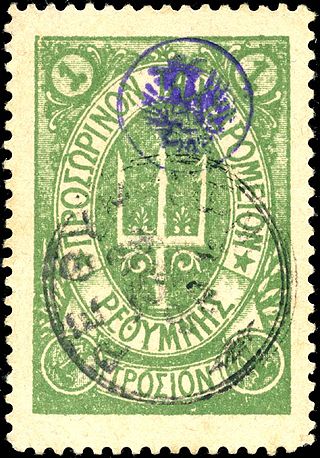
The Russian post offices in Crete were established by Russia in the area of Crete it occupied as part of the joint occupying force that arrived in 1898.
The Russian post offices in the Ottoman Empire were a set of post offices operated by Russia in various cities of the Ottoman Empire from the late 18th century until September 1914.

Souda Bay is a bay and natural harbour near the town of Souda on the northwest coast of the Greek island of Crete. The bay is about 15 km long and only two to four km wide, and a deep natural harbour. It is formed between the Akrotiri peninsula and Cape Drapano, and runs west to east. The bay is overlooked on both sides by hills, with a relatively low and narrow isthmus in the west near Chania.

Postage stamps and postal history of the Canal Zone is a subject that covers the postal system, postage stamps used and mail sent to and from the Panama Canal Zone from 1904 up until October 1978, after the United States relinquished its authority of the Zone in compliance with the treaty it reached with Panama.

This is a survey of the postage stamps and postal history of Lithuania.
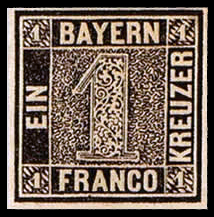
This is a survey of the postage stamps and postal history of Germany and philatelically related areas. The main modern providers of service were the Reichspost (1871–1945), the Deutsche Post under Allied control (1945–1949), the Deutsche Post of the GDR (1949–1990), the Deutsche Bundespost (1949–1995), along with the Deutsche Bundespost Berlin (1949–1990), and are now the Deutsche Post AG.

The postal history of Turkey and its predecessor state, the Ottoman Empire, dates to the 18th century when foreign countries maintained courier services through their consular offices in the Empire. Although delayed in the development of its own postal service, in 1863 the Ottoman Empire became the second independent country in Asia to issue adhesive postage stamps, and in 1875, it became a founding member of the General Postal Union, soon to become the Universal Postal Union. The Ottoman Empire became the Republic of Turkey in 1923, and in the following years, its postal service became more modernized and efficient and its postage stamps expertly designed and manufactured.
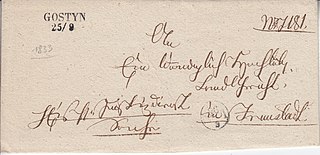
Poczta Polska, the Polish postal service, was founded in 1558 and postal markings were first introduced in 1764. The three partitions of Poland in 1772, 1793 and 1795 saw the independent nation of Poland disappear. The postal services in the areas occupied by Germany and Austria were absorbed into those countries' postal services. In 1772 the area occupied by Austria was created into the Kingdom of Galicia, a part of the Austrian Empire. This lasted till 1918. The Duchy of Warsaw was created briefly, between 1807 and 1813, by Napoleon I of France, from Polish lands ceded by the Kingdom of Prussia under the terms of the Treaties of Tilsit. In 1815, following Napoleons' defeat in 1813, the Congress of Vienna, created Congress Poland out of the Duchy of Warsaw and also established the Free City of Kraków. Congress Poland was placed under the control of Russia and the postal service was given autonomy in 1815. In 1851 the postal service was put under the control of the Russian post office department regional office in St Petersburg. In 1855 control was restored for a while to the Congress Kingdom but following the uprising in 1863 again came under Russian control from 1866 and continued until World War I. In November 1918 the Second Polish Republic was created.
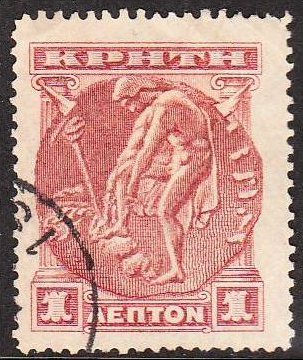
This is a survey of the postage stamps and postal history of Crete.

The Greek god Hermes, messenger of the Gods in the Greek mythology, is the representation chosen, in 1860, by the Kingdom of Greece to illustrate its first postal stamps.
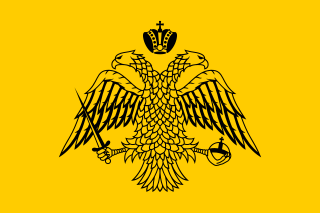
The monastic community of Mount Athos is an Eastern Orthodox community of monks in Greece who hold the status of an autonomous region with its own sovereignty within Greece and the European Union, as well as the combined rights of a decentralized administration, a region and a municipality, with a territory encompassing the distal part of the Athos peninsula including Mount Athos. The bordering proximal part of the peninsula belongs to the regular Aristotelis community in Central Macedonia.

The Protaton, also known as the Dormition of the Theotokos Church, is the main church of Karyes, Mount Athos. It also serves as the ecclesiastical seat of the Protos, or the primate of the monastic community of Mount Athos. It was founded in the early 10th century AD, prior to the completion of the Great Lavra in 963.